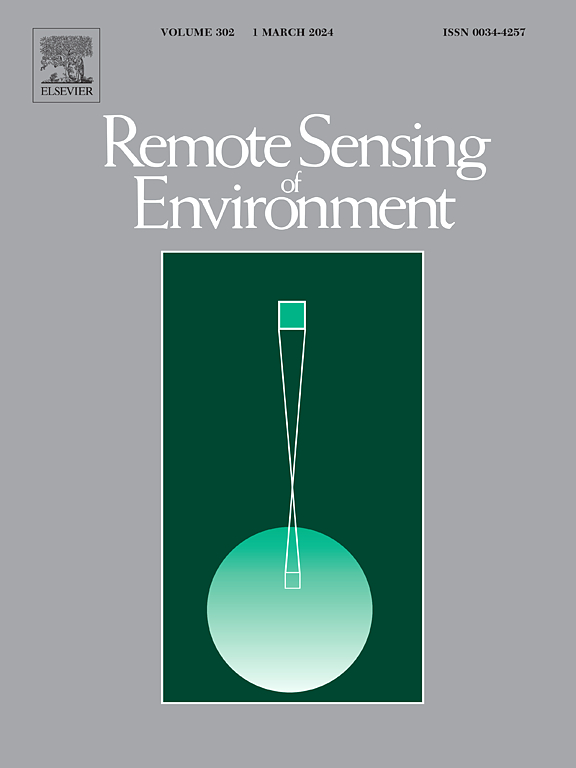Net primary production in the Labrador Sea between 2014 and 2022 derived from ocean colour remote sensing based on ecological regimes
IF 11.1
1区 地球科学
Q1 ENVIRONMENTAL SCIENCES
引用次数: 0
Abstract
Phytoplankton play a major role in carbon export and storage in the ocean interior through remineralization of particulate carbon into dissolved inorganic carbon (DIC), and represent the “gain” side of the biological carbon pump. Shifts in phytoplankton community structure and species succession impact primary production, quality of food for zooplankton consumers and the fate of organic matter in marine ecosystems.
In the Labrador Sea (LS), a sub-arctic environment, the emergence of large blooms of Phaeocystis spp. in spring at the expenses of diatoms may disrupt phytoplankton species succession with drastic consequences on the carbon cycle and the functioning of the marine ecosystem as these small flagellates aggregate in colonies of up to several millimeters, embedded in gelatinous matrices, that modify elemental stoichiometry, sinking rates and transfer of energy to higher trophic levels. In this study, we develop an ecological approach to estimate primary production due to Phaeocystis sp. in the LS from satellite remote sensing data. We used a regionally-tuned primary production model to assign phytoplankton photosynthesis efficiency as a function of oceanographic regimes defined by phytoplankton community structure and biomass, and sea-surface temperature. We found that four oceanographic regimes corresponded to broad phytoplankton taxonomic assemblages and environmental factors in the LS: the diatom-dominated Shelf, the low chlorophyll-a Basin, the mesotrophic Basin regimes and a last oceanographic regime within the Basin, where the flagellated prymnesiophyte Phaeocystis spp. likely dominated the assemblage. Annual primary production in the Labrador Sea varied between 200 and 300 Tg of carbon between 2014 and 2022 in agreement with previous studies. While Phaeocystis spp. contributed about 10 % of the annual production, two unusual blooms that occurred in 2015 and 2022 contributed about 14 and 20 % of total production, respectively. During these two events Phaeocystis sp. contributed 40 % and 60 % to the May production and extended over more than half the Labrador Sea. Spring blooms dominated by Phaeocystis may occur more frequently due to climate change and have the potential to impact the fate of carbon and alter the functioning of the LS ecosystem.
2014年至2022年间,拉布拉多海的净初级产量来自基于生态制度的海洋颜色遥感
浮游植物通过将颗粒碳再矿化转化为溶解的无机碳(DIC),在海洋内部发挥着重要的碳输出和储存作用,是生物碳泵的“增益”方。浮游植物群落结构和物种演替的变化影响着初级生产、浮游动物消费者的食物质量和海洋生态系统中有机物的命运。在拉布拉多海(LS)的亚北极环境中,以硅藻为代价的大量Phaeocystis sp .在春季出现的大量繁殖可能会破坏浮游植物物种的演替,对碳循环和海洋生态系统的功能造成严重后果,因为这些小鞭毛虫聚集在长达几毫米的菌落中,嵌入胶状基质,改变元素化学计量、下沉速率和能量向更高营养水平的转移。在本研究中,我们开发了一种基于卫星遥感数据的生态方法来估计LS中Phaeocystis sp.的初级产量。我们使用了一个区域调整的初级生产模型,将浮游植物光合作用效率分配为浮游植物群落结构和生物量以及海面温度定义的海洋制度的函数。研究发现,陆架硅藻为主的陆架、低叶绿素a盆地、中营养型盆地和陆架内以鞭毛原体Phaeocystis spp为主的最后一种海洋格局与陆架内广泛的浮游植物分类组合和环境因子相对应。与之前的研究一致,2014年至2022年,拉布拉多海的年初级产量在200至300 Tg之间变化。虽然Phaeocystis sp .贡献了约10%的年产量,但2015年和2022年发生的两次不寻常的花华分别贡献了约14%和20%的总产量。在这两次活动中,Phaeocystis sp对5月份的产量贡献了40%和60%,并扩展到拉布拉多海的一半以上。由于气候变化,以Phaeocystis为主的春华可能会更频繁地发生,并有可能影响碳的命运和改变LS生态系统的功能。
本文章由计算机程序翻译,如有差异,请以英文原文为准。
求助全文
约1分钟内获得全文
求助全文
来源期刊

Remote Sensing of Environment
环境科学-成像科学与照相技术
CiteScore
25.10
自引率
8.90%
发文量
455
审稿时长
53 days
期刊介绍:
Remote Sensing of Environment (RSE) serves the Earth observation community by disseminating results on the theory, science, applications, and technology that contribute to advancing the field of remote sensing. With a thoroughly interdisciplinary approach, RSE encompasses terrestrial, oceanic, and atmospheric sensing.
The journal emphasizes biophysical and quantitative approaches to remote sensing at local to global scales, covering a diverse range of applications and techniques.
RSE serves as a vital platform for the exchange of knowledge and advancements in the dynamic field of remote sensing.
 求助内容:
求助内容: 应助结果提醒方式:
应助结果提醒方式:


